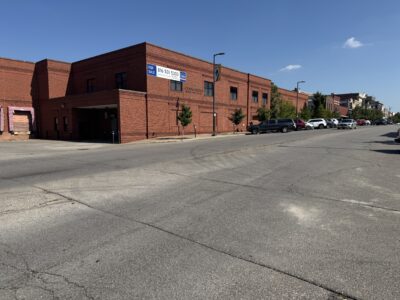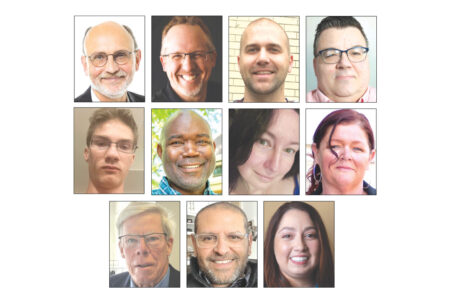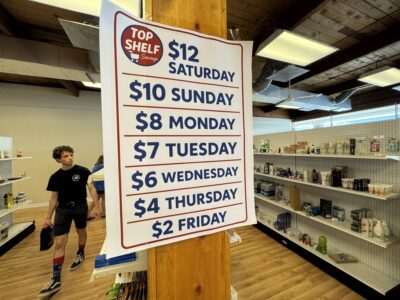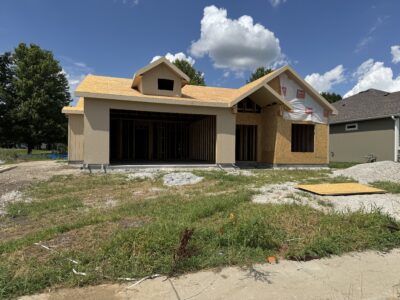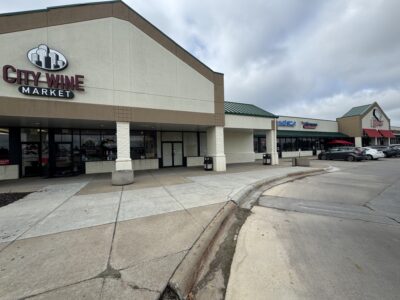
After months of being stagnant, Lawrence retail sales soar, according to latest report

photo by: Nick Krug
A cashier hands a receipt back to a customer after a purchase at Lawrence's Sunflower Outdoor and Bike Shop in this file photo from July 6, 2017.
I have never gotten excited about the phrase “Christmas in July” because it usually has ended with a touch of heat stroke after cutting down a Pine tree in the Kansas heat. But City Hall officials may be appreciative of the phrase about now.
The state’s July sales tax report showed a large uptick in economic activity in Lawrence. Taxable sales for the month were up 13.7% from the same month a year ago. The news might be a gift in the form of peace of mind for Lawrence officials who are putting together the city’s 2026 budget.
Lawrence had been on a multi-month streak of tepid sales tax returns in 2025, which was creating questions about whether the city’s 2025 budget would fall short of its sales tax projections. Any such shortfall would make crafting the 2026 budget more difficult, as sales taxes are the largest source of revenue for the city’s general operating fund.
The July report doesn’t eliminate all the city’s sales tax worries, but it does provide a significant boost. The city generally needs to see real sales tax growth of about 5% this year — all these numbers factor out Lawrence’s voter-approved increase to the sales tax rate — in order to hit its budget mark. The city started the year with a huge 18% increase, but has seen pretty anemic growth ever since. As a result, at the halfway mark of the year, Lawrence’s sales tax growth was at 4.1% and seemingly losing ground each month.
With this latest report, though, Lawrence’s retail sales are up 4.95% for the year. That should help city leaders feel more confident that the 5% growth figure is still a reasonable one for this year.
Just as important, the improvement in sales tax numbers might give city commissioners some confidence in adopting a somewhat aggressive projection for sales tax revenues in 2026. A key part of crafting the city’s budget is the assumption you use for how much sales tax revenues will grow in the next year. You can erase a pretty sizable budget deficit simply by increasing your assumed growth rate for sales tax collections. You can also alleviate the need for a property tax rate increase by using the same strategy.
Of course, the key is whether the assumption is reasonable. An unreasonable assumption might make your budget look better when it is approved, but it may become a real headache in the months to come if sales tax growth doesn’t materialize.
I’ve never envied the officials who have to predict sales tax growth. It is harder than predicting the weather, and they have to put up with guys like me who write an article every month about how the projections are holding up to reality. But, sales taxes are critical to the city’s operations, thus the attention.
Also, thus the worry. The 2025 numbers thus far are not likely to make City Hall budget-makers feel comfortable. The nearly 5% growth is very respectable, and would be a nice number for the 2026 budget. However, the growth has been so uneven. It really has come from just two months — the January report that posted an 18% increase and the July report that posted a 13% increase. The rest of the months have been pretty stagnant.
To compound matters, it is not really clear why either one of those months had a big increase. I can tell you what wasn’t the reason with this latest report: People buying actual Christmas presents in July. I know this because the July report doesn’t actually measure sales made in July. Due to normal delays in reporting, it measured sales made in late May and early June.
The report likely did capture a fair amount of retail spending that occurred as part of KU’s Commencement ceremonies. I can attest that you get temporarily giddy with the wallet when you realize you no longer have to send a tuition check to the university. So, perhaps spending levels were higher for commencement visitors this year than last year. But, that is complete speculation.
Whatever the case, city commissioners will have to decide their comfort level on 2026 predictions in the next month or so, as they finalize the budget. You could argue that 2026 is poised to be a really good year for sales tax collections, but that is based on a belief that Lawrence will serve as a “base camp” for one of the teams that qualify for the World Cup soccer tournament. Such a designation would produce a ton of international visitors staying for an extended time period. There is optimism Lawrence will receive a base camp designation, thanks to the facilities at Rock Chalk Park. But I’ve also heard things that make me think that is far from a done deal.
I’m tempted to say it is a “on-the-one-hand versus the-other-hand” argument, but I don’t think that is allowed in soccer conversations. Oh, well. Here’s a look at how Lawrence fared compared to other cities and the state as a whole during the most recent one-month period.
• Lawrence: up 13.7%
• Olathe: up 11.4%
• Lenexa: up 10.8%
• Kansas City: up 8.5%
• Merriam: up 7.9%
• Sedgwick County: up 7.4%
• Salina: up 5.2%
• Topeka: up 3.1%
• Manhattan: up 2.0%
• Shawnee: up 1.4%
• Statewide: up 6.4%
Here’s a look at how Lawrence stacks up those communities on a year-to-date basis.
• Merriam: up 6.9%
• Manhattan: up 5.3%
• Lawrence: up 4.9%
• Sedgwick County: up 4.7%
• Salina: up 3.9%
• Olathe: up 3.3%
• Topeka: up 3.2%
• Kansas City: up 1.5%
• Shawnee: up 1.1%
• Lenexa: up 0.7%
• Statewide: up 4.3%


